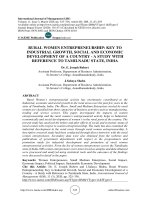Economic growth and economic development 32
Bạn đang xem bản rút gọn của tài liệu. Xem và tải ngay bản đầy đủ của tài liệu tại đây (44.15 KB, 1 trang )
Introduction to Modern Economic Growth
level. Figure 1.12 shows that as we go further back, the gap among countries becomes
much smaller. This further emphasizes that the big divergence among countries has
taken place over the past 200 years or so. Another noteworthy feature that becomes
apparent from this figure is the remarkable nature of world economic growth. Much
evidence suggests that there was little economic growth before the 18th century and
certainly almost none before the 15th century. Maddison’s estimates show a slow
but steady increase in West European GDP per capita between 1000 and 1800. This
view is not shared by all historians and economic historians, many of whom estimate
that there was little increase in income per capita before 1500 or even before 1800.
For our purposes however, this is not central. What is important is that starting in
the 19th, or perhaps in the late 18th century, the process of rapid economic growth
takes off in Western Europe and among the Western Offshoots, while many other
parts of the world do not experience the same sustained economic growth. We owe
our high levels of income today to this process of sustained economic growth, and
Figure 1.12 shows that it is also this process of economic growth that has caused
the divergence among nations.
Figure 1.13 shows the evolution of income per capita for United States, Britain,
Spain, Brazil, China, India and Ghana. This figure confirms the patterns shown in
Figure 1.11 for averages, with the United States Britain and Spain growing much
faster than India and Ghana throughout, and also much faster than Brazil and
China except during the growth spurts experienced by these two countries.
Overall, on the basis of the available information we can conclude that the origins of the current cross-country differences in economic performance in income
per capita formed during the 19th century and early 20th century (perhaps during
the late 18th century). This divergence took place at the same time as a number
of countries in the world started the process of modern and sustained economic
growth. Therefore understanding modern economic growth is not only interesting
and important in its own right, but it also holds the key to understanding the causes
of cross-country differences in income per capita today.
18









